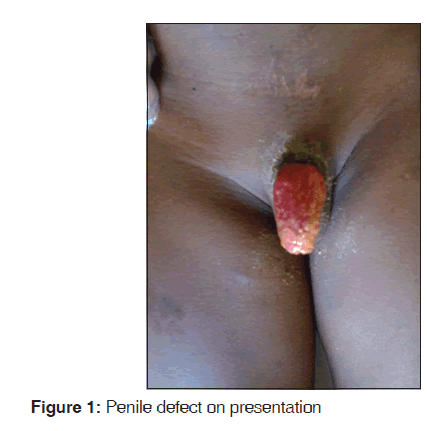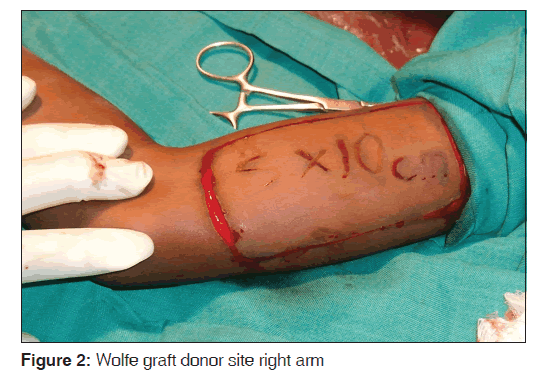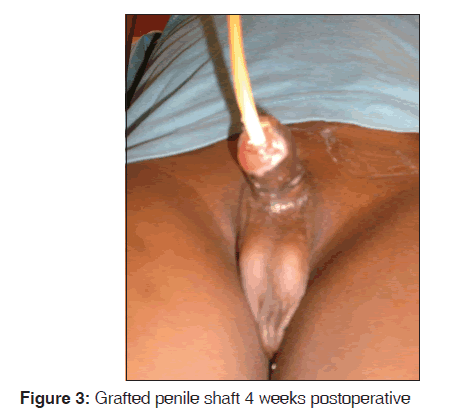Isolated Penile Degloving from Milling Machine Injury in a Child
- *Corresponding Author:
- Dr. Onumaegbu OO
Department of Surgery, University of Nigeria Teaching Hospital, Enugu, 400001, Nigeria.
E-mail: okechukwu.onumaegbu@ unn.edu.ng
Abstract
Degloving injuries of the male perineum are an uncommon urological emergency often requiring reconstruction. They are usually related to industrial and/or agricultural machinery and tend to involve both the penile shaft and the scrotal skin. Adolescents and young adults are the usual victims. The treatment options commonly employed include the use of the degloved skin either as a flap or more often as a free skin graft, yielding variable results. Other modalities include the use of free split skin grafts or free full thickness skin grafts (FTSG) (Wolfe grafts). We report a case of degloving injury in a 10‑year‑old child, with injury exclusively affecting the skin of the penile shaft, who presented in the sub‑acute phase. Optimization of the wound and subsequent cover of the defect with an FTSG yielded a good outcome and patient satisfaction.
Keywords
Circumferential penile skin loss, Delayed presentation, Isolated penile degloving, Pediatric penile degloving, Wolfe graft
Introduction
Degloving describes a potentially serious injury in which an extensive area of skin is torn from its underlying attachments consequently depriving it of its blood supply. [1] Degloving injury of the male genitals is an uncommon urological presentation. [2-4] They occur mainly following accidents with industrial or agricultural equipment. [2,4-8] They are, therefore, rare in children. [2,8] Commoner pediatric penile injuries include iatrogenic circumcision-related injuries, toilet seat injuries as well as zipper injuries. [5,9,10] Isolated degloving injury of the penile skin is a rare emergency in the pediatric age group. [3] A case of isolated penile degloving injury in a 10-year-old boy arising from avulsion effect of clothing entrapped in a milling machine is presented. Reconstruction was achieved with a full thickness skin graft (FTSG), after initial wound optimization. Delayed presentation on account of initial care offered at a peripheral health facility prolonged the duration of care this patient received. We present this report to highlight the peculiar presentation of this injury. It not only involved a child, but the full thickness skin loss affected only the penile shaft skin sparing the scrotum and adjacent perineal skin. The injury risk associated with the practice of allowing minors operate delicate machinery is equally demonstrated.
Case Report
A 10-year-old boy was referred to the plastic surgery outpatient, with a 3-week history of degloving injury to the penile shaft. He had been attending to a cassava milling machine in his village, in Ubakala Old Umuahia, South East Nigeria, when his shorts accidentally got caught in the running fan belt of the milling machine. He was found upon rescue to be in pain, with his phallus entrapped by his clothes. The shorts had been tightly wrung by the pulley/fan belt system of the machine. Initial presentation was at a peripheral hospital where bleeding from the injured penis was controlled, and daily dressing instituted. Details of care given over a period up to the presentation to our service remained sketchy. There was no history of urethral catheterization in the course of the prereferral management.
Physical findings upon presentation include complete degloving of the entire penile shaft with infected unhealthy granulation tissue overgrowth [Figure 1]. He was otherwise healthy. The patient was admitted, and investigations ordered including wound swab for microscopy, culture and sensitivity (m/c/s), full blood count, and urinalysis. A urethral catheter was passed for intermittent bladder drainage. Daily dressing with povidone-iodine-wrung gauze was commenced. Wound swab culture result was coliform organisms; other investigative modalities returned normal range values.
Upon the wound cleaning out, with healthy granulation tissue formation, reconstruction was undertaken. An FTSG cover was employed with a zigzag interpolation of skin at the penoscrotal junction. The Wolfe graft, measuring 5 cm × 10 cm [Figure 2] was harvested from the medial aspect of the right arm and the donor site defect split skin-grafted. The Wolfe graft was draped over the dorsum of the penile shaft and the ends sutured in apposition ventrally. Graft “take” was good over the secondary defect as well as on the penile shaft on day 7 postoperative. At the root of the penis, a 3 mm loss of graft was noted, dorsally. Alternate daily tulle gras dressing was commenced on ambulant basis. On follow-up, graft consolidation remained progressive while the dorsal root defect had reepithelialized [Figure 3]. The urethral catheter was removed 4 weeks postoperative. The patient was lost to follow-up thereafter.
Discussion
In many rural and semi-urban settings in Nigeria, small scale industries are common. These include bakeries, cassava (“gari”) processing outfits, and wood-work plants among others. Machines employed in these setups are not unusual causes of injury to the operators. These injuries often involve the organ of prehension [11] - the hands-being the part of the body often put into these machines to drive the raw materials into the grinding or kneading work ends.
This report highlights an unusual case of isolated penile degloving injury in a child who was operating one of these machines, presumably, in a noncommercial setting. The exact nature of the primary injury is beclouded by the patient’s late presentation after futile inadequate management in a peripheral health facility.
Machinery injuries are not uncommon. [2,4-8] “Bread rolling” (dough kneading) machines, cassava grating/grinding machines are often implicated in our environment. Males of adult and adolescent age group are the usual victims. [6-8] The upper limb especially the hands are usually the organs entrapped between the moving parts of these machines. [11] Typically, one limb gets entrapped with or without involvement of the other limb which may become involved in the course of attempting to overcome the entrapment. Isolated injury to the phallus is not the usual presentation. Children are not often victims of these injuries given that, though they are often partakers in the small scale industry activities, they usually play supportive roles such as fetching water, washing up and minor porterage of the raw materials as well as some of the finished products. The mechanism of this injury to the phallus differs from the usual mechanism of injury to the extremities. The use of loose clothing materials like the Hindu dhoti or baggy trousers has been associated with the incidence of industrial and/or agricultural machine parts snagging these and pulling out the penile skin. [2,6] The index patient had on a pair of shorts and no underwear. This was effectively loose enough to be snagged by the machine part. Close-fitting workman clothing materials, like jeans, are less likely to be so snagged. The lost tissue in this child was the full thickness of the hairless skin of the penile shaft. Whether this full thickness loss was a consequence of the primary injury or a complication of the initial inadequate care is indeterminate. This depth of the skin loss informed the choice of the inner aspect of the arm as a donor site for the Wolfe graft. This site is relatively hairless, [3] as is the lost penile skin. The interpolation of the skin at the root of the penis was to break the line of the scar in order to preclude a constrictive effect at the root of the penis. [3] Although split skin graft (SSG) cover for penile skin loss is documented, [1-3,7] the extent of and nature of involvement in our index case would contraindicate its use here. The contraction and inelasticity associated with SSGs would be restrictive to the erectile capacity of this organ when needed. [7]
Conclusion
Milling machine injuries are not uncommon. The prehensile organs and the adjoining distal portions of the upper limbs are often affected. For similar reasons, other “appendages” can be affected, not least the phallus. Proper care in the use of these machines includes not having them operated by underage persons. With respect to the management of the index case, the rule of “replacing like with like” in cases of tissue loss, was followed, yielding a satisfactory outcome. Avulsion injuries should be treated as emergencies. When they involve such delicate structures as the male phallus, prompt expert care should be the goal to avoid unacceptable complications. This early surgical repair of the penile skin loss is emphasized, since prolonged exposure of the denuded penis is associated with increased risk of secondary infection and fibrotic changes that would mar a favorable outcome.
References
- Antoniou D, Kyriakidis A, Zaharopoulos A, Moskoklaidis S. Degloving injury Eur J Trauma 2005;31:593-6.
- Mathur RK, Lahoti BK, Aggarwal G, Satsangi B. Degloving injury to the penis. Afr J Paediatr Surg 2010;7:19-21.
- Jha AK, Singh S, Gupta S. Split thickness skin graft for penile skin avulsion – Simple solution for a rare injury. Surg Clin India 2012;1:1-3.
- Finical SJ, Arnold PG. Care of the degloved penis and scrotum: A 25-year experience. Plast Reconstr Surg 1999;104:2074-8.
- Sarin YK, Sinha A, Ojha S. “Snapped in” penis: An unusual presentation of degloving injury of the penis. Indian J Urol 2004;20:56-7.
- Selvan SS, Alagu GS, Gunasekaran R. Use of a hypogastric flap and split-thickness skin grafting for a degloving injury of the penis and scrotum: A different approach. Indian J Plast Surg 2009;42:258-60.
- Kiffin C, Porcelli M, Prychyna O, Pazmino B, Pust D, Decostanza J. Penile degloving injury in an adolescent with congenital hypothyroid. Case Rep Med 2012;2012:464670.
- Paraskevas KI, Anagnostou D, Bouris C. An extensive traumatic degloving lesion of the penis. A case report and review of the literature. Int Urol Nephrol 2003;35:523-7.
- Gapany C, Tercier S, Frey P. Primary suture of a child’s penis degloving injury: Anatomical basis for success. J Pediatr Surg Spec 2008;2:48-9.
- Wyatt JP, Scobie WG. The management of penile zip entrapment in children. Injury 1994;25:59-60.
- Okeke LI, Dogo D, Ladopi JK, Ajao OG. Grinding machine injury of the hand: A preliminary report. East Afr Med J 1992;69:44-6.







 The Annals of Medical and Health Sciences Research is a monthly multidisciplinary medical journal.
The Annals of Medical and Health Sciences Research is a monthly multidisciplinary medical journal.